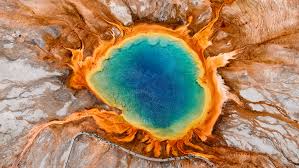Yellowstone Supervolcano:

A “breathing” cap of magma has been discovered inside the Yellowstone supervolcano, and it might help determine when the volcano will next erupt, a new study has found.
- Yellowstone Supervolcano lies beneath Yellowstone National Park, in the western United States.
- It is one of the largest active volcanic systems in the world.
- It’s a caldera (a large crater formed by a major eruption) and an active supervolcanic system.
- The caldera formed when pyroclastic material exploded out of the volcano, partly emptying the magma chamber causing the roof to collapse.
- When the roof collapsed over the magma chamber, it created a bowl shaped depression in the ground.
- Three enormous eruptions occurred at the Yellowstone hotspot 2.1 million, 1.3 million, and 640,000 years ago.
- Two of these released so much material that the area is often referred to as a supervolcano.
- A supervolcano is a volcano that at one point in time erupted more than 1,000 cubic kilometers of deposits.
- One recent study estimates that another supervolcanic eruption at Yellowstone would blanket North America in ash, and some areas close to the hotspot could be covered by more than a meter of debris.
- Supervolcanoes can also have pronounced cooling effects on the climate for several years after an eruption because of the sulfur dioxide that is released to the atmosphere.
- The sulfur dioxide forms aerosols that block incoming sunlight.
- Eventually, the sulfur dioxide from the eruption will wash out of the atmosphere, and the climate cooling effect will subside.




